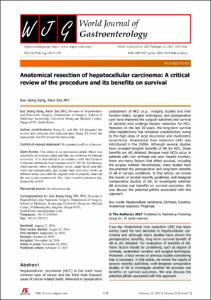Anatomical resection of hepatocellular carcinoma: A critical review of the procedure and its benefits on survival
- Keimyung Author(s)
- Kang, Koo Jeong; Ahn, Keun Soo
- Department
- Dept. of Surgery (외과학)
- Journal Title
- World Journal of Gastroenterology
- Issued Date
- 2017
- Volume
- 23
- Issue
- 7
- Abstract
- Hepatocellular carcinoma (HCC) is the sixth most common type of cancer and the third most frequent cause of cancer-related death. Advances in preoperative assessment of HCC (e.g., imaging studies and liver function tests), surgical techniques, and postoperative care have improved the surgical outcomes and survival of patients who undergo hepatic resection for HCC. However, in the last 20 years, the long-term survival after hepatectomy has remained unsatisfactory owing to the high rates of local recurrence and multicentric occurrence. Anatomical liver resection (AR) was introduced in the 1980s. Although several studies have revealed tangible benefits of AR for HCC, these benefits are still debated. Because most HCCs occur in patients with liver cirrhosis and poor hepatic function, there are many factors that affect survival, including the surgical method. Nevertheless, many studies have documented the perioperative and long-term benefits of AR in various conditions. In this article, we review the results of several recently published, well-designed comparative studies of AR, to investigate whether AR provides real benefits on survival outcomes. We also discuss the potential pitfalls associated with this approach.
- Publisher
- School of Medicine
- Citation
- Koo Jeong Kang and Keun Soo Ahn. (2017). Anatomical resection of hepatocellular carcinoma: A critical review of the procedure and its benefits on survival. World Journal of Gastroenterology, 23(7), 1139–1146. doi: 10.3748/wjg.v23.i7.1139
- Type
- Article
- ISSN
- 1007-9327
- Appears in Collections:
- 1. School of Medicine (의과대학) > Dept. of Surgery (외과학)
- 파일 목록
-
-
Download
 oak-2017-0429.pdf
기타 데이터 / 917.91 kB / Adobe PDF
oak-2017-0429.pdf
기타 데이터 / 917.91 kB / Adobe PDF
-
Items in Repository are protected by copyright, with all rights reserved, unless otherwise indicated.